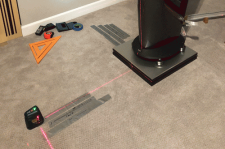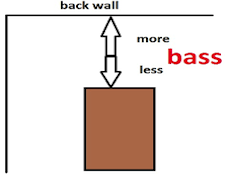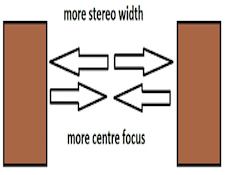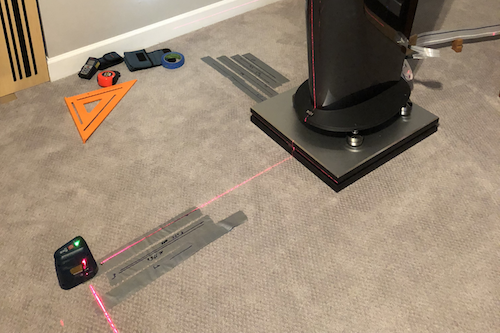It’s the time of year for saving money!
Apart from mounting a cartridge on a tonearm, speaker positioning specifically and room set up in general are perhaps among the more difficult aspects of high performance audio. In regard to speaker positioning, what I find frustrating is that little nagging voice telling me regardless how wonderful it sounds, it could possibly be even better with additional adjustment.
 Speaker set up methodologies abound. Too many, in fact, to list all of them much less try them. More frustrating still, any of these set up methods are little more than a very good starting point because all rooms are different – and obtaining ideal sonics typically requires a little “massaging” on the part of the listener.
Speaker set up methodologies abound. Too many, in fact, to list all of them much less try them. More frustrating still, any of these set up methods are little more than a very good starting point because all rooms are different – and obtaining ideal sonics typically requires a little “massaging” on the part of the listener.
For those who have a conventional dynamic speaker with all the drivers mounted on the front of a nice rectangular box, taking accurate measurements is decisively simple. What happens if, like myself, you have side mounted woofers in an irregular shaped cabinet? Anyone with, to name a few, Vivid Giya speakers, the Sonus Faber Limited Edition, Rockport Arrakis, Golden Ear and yes, even my KEF Blades must contend with side mounted drivers. With a conventional speaker, dimensions to both side walls as well as the front wall may be taken from the same reference point on the speaker. With a side firing woofer, dimensionality to the side and front walls, depending on the speaker, might be from two different points. Fine if this fact is known, and if not, well, sonic issues potentially await.
Another issue with accurate measurements is the shape of the cabinet. Again, conventional dynamic speakers have nice straight lines from which to take a measurement. What happens if your speakers, like my Blades, have very little in the way of a flat or straight surface? I’ll tell you, measurement accuracy becomes quite inventive.
 Prior to my visit this past November to KEF, I decided to learn all I could about my room and enlist the advice of Jack Oclee-Brown, lead acoustical engineer for KEF with some helpful tips on speaker placement. What I discovered was quite surprising.
Prior to my visit this past November to KEF, I decided to learn all I could about my room and enlist the advice of Jack Oclee-Brown, lead acoustical engineer for KEF with some helpful tips on speaker placement. What I discovered was quite surprising.
Deciding to ensure I had correct room dimensions, I began by taking eight measurements of the distance between the side walls along the entire twenty-six-foot room length. Think there was any possibility the walls were straight? Of course not. There were actually four different dimensions. So right away, I realized I had an additional issue in getting the side wall measurements equivalent on both speakers. And with the back of the cabinet on my Blades radiused over, having a flat surface to use the laser measurer would be difficult at best. There must be a better way. With nine hours home on the return flight from Zurich, and in between meals, inflight movies, and maybe a little sleep, I hoped to come up with an innovative solution.
When talking with Jack at KEF, he admitted the lack of a straight edge on the Blades presented a placement challenge. His advice, and one that could probably be used with any speaker with side firing woofers, was to use the UniQ driver on the front as the datum for the side walls and the vertical center of the side mounted woofer as the datum for the front wall dimensions. And right away I realized I had been doing things wrong since my measurements were all to the UniQ. Strike one for lessons not learned. This was useful information for sure, but my other issues remained unsolved – non-parallel side walls and the lack of straight lines on the cabinets. Somewhere, above perhaps Greenland, one answer presented itself.
 I was thinking about where I was going to hang a copper engraving I had purchased in Europe. One place was beside one I already have and I thought “a laser level would help ensure I got both pictures at the same height.” Wait, a laser level? Why wouldn’t that work with speaker placement? I could take a reference point on the floor in front of the speaker and take a measurement to the side wall. I could then apply a piece of duct tape on the carpet, draw a straight line on it and use that as a reference for the laser level. Do the same thing on the other speaker and I remove non-parallelism of the side walls from the equation. That might work.
I was thinking about where I was going to hang a copper engraving I had purchased in Europe. One place was beside one I already have and I thought “a laser level would help ensure I got both pictures at the same height.” Wait, a laser level? Why wouldn’t that work with speaker placement? I could take a reference point on the floor in front of the speaker and take a measurement to the side wall. I could then apply a piece of duct tape on the carpet, draw a straight line on it and use that as a reference for the laser level. Do the same thing on the other speaker and I remove non-parallelism of the side walls from the equation. That might work.
Upon returning home, I went to Lowe’s and purchased a Bosch laser level that projects a red beam in both the vertical and horizontal planes. Lining up the vertical beam of the laser level with the line on the tape on the floor was easy. And moving the Blades so the beam bisected the UniQ driver was also pretty simple. Repeating the process for the side mounted woofers proved equally manageable. So now, starting with whatever positioning formula that works best, I had a repeatable and surprisingly precise method to position my speakers. Best of all, it worked to stunning effect. My system has never sounded better.
![AR-]RoomRoflections.jpg](http://cdn-5f7e6584c1ac190fbc5797e3.closte.com/assets_c/2018/01/RoomRoflections-thumb-225x175-10885.jpg) I firmly believe in precise measurements for speaker placement. In any enclosed space, and one that maintains a mostly constant temperature and barometric pressure, and since altitude in my home isn’t changing, the speed of sound is very consistent. Also, because the walls, floor and ceiling are not moving, reflections are very repeatable. The only real variable is speaker placement. So to achieve ideal imaging both linear and front to back, and also enlist commanding bass response, precise speaker placement is essential – something consistently proven to me in my listening room.
I firmly believe in precise measurements for speaker placement. In any enclosed space, and one that maintains a mostly constant temperature and barometric pressure, and since altitude in my home isn’t changing, the speed of sound is very consistent. Also, because the walls, floor and ceiling are not moving, reflections are very repeatable. The only real variable is speaker placement. So to achieve ideal imaging both linear and front to back, and also enlist commanding bass response, precise speaker placement is essential – something consistently proven to me in my listening room.
As speaker designers move away from nice rectangular boxes and towards more “fluid” shapes, speaker positioning will become more difficult. My method, while working very well for me, may not work for everyone. What is undeniable is that proper speaker placement will profoundly enhance the listening experience. All that is required is a really great way to do so.








